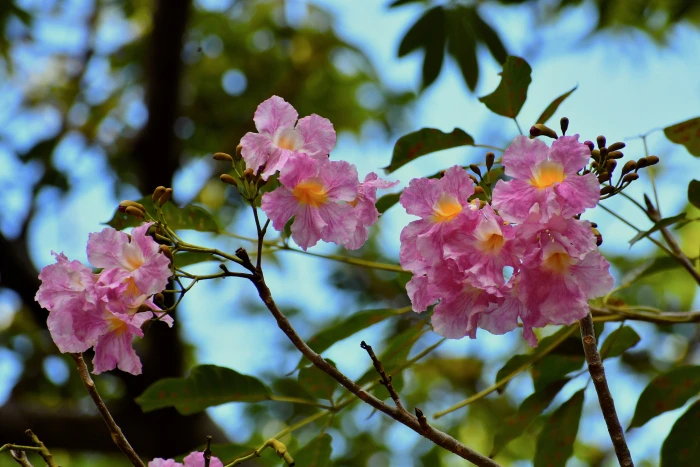Rosy Trumpet Tree
(Tabebuia rosea)
Rosy Trumpet Tree (Tabebuia rosea)
/
/

Daniel Pineda Vera
CC BY 4.0
Image By:
Daniel Pineda Vera
Recorded By:
Copyright:
CC BY 4.0
Copyright Notice:
Photo by: Daniel Pineda Vera | License Type: CC BY 4.0 | License URL: http://creativecommons.org/licenses/by/4.0/ | Rights Holder: Daniel Pineda Vera | Publisher: iNaturalist | Date Created: 2020-02-14T08:57:11-08:00 |










































Estimated Native Range
Climate Requirements
| • Precipitation | 47" - 56" |
| • High Temp. | 86°F - 95°F |
| • Low Temp. | 57°F - 71°F |
Summary
Tabebuia rosea, commonly known as Rosy Trumpet Tree, is an evergreen or semi-deciduous tree native to Mexico, Central America and Northern South America. It can grow up to 30 meters (98 feet) tall with a trunk diameter of up to 100 cm (3 feet). The tree has a short stature with a few thick branches and stratified ramification, creating an irregular canopy. The Rosy Trumpet Tree is renowned for its spectacular floral display, with large, trumpet-shaped flowers in shades of pink to purple. These blooms are most prolific from January to February during dry periods, but flowering can also occur in August, September, April, and May. The flowers emerge when the tree has few or no leaves, enhancing their visual impact. Pollination is likely insect-driven, but the blossoms attract a variety of birds, including tanagers, hummingbirds, and orioles.
The Rosy Trumpet Tree is valued for its dual seasonal interest: providing dense shade in the rainy season and a dramatic floral display on the leafless branches in the dry season. It is widely used in urban landscapes, particularly in parks and gardens. The tree adapts well to full sun and a range of soil drainage conditions, from slow to fast. While it requires medium amounts of water, it is somewhat drought-tolerant once established. One potential issue is that it can be susceptible to fungal diseases, especially in overly moist conditions. Gardeners should be aware of its moderate growth rate and plan for its eventual size when planting.CC BY-SA 4.0
The Rosy Trumpet Tree is valued for its dual seasonal interest: providing dense shade in the rainy season and a dramatic floral display on the leafless branches in the dry season. It is widely used in urban landscapes, particularly in parks and gardens. The tree adapts well to full sun and a range of soil drainage conditions, from slow to fast. While it requires medium amounts of water, it is somewhat drought-tolerant once established. One potential issue is that it can be susceptible to fungal diseases, especially in overly moist conditions. Gardeners should be aware of its moderate growth rate and plan for its eventual size when planting.CC BY-SA 4.0
Plant Description
- Plant Type: Tree
- Height: 60-90 feet
- Width: 30-50 feet
- Growth Rate: Moderate
- Flower Color: Yellow, Pink, White
- Flowering Season: Spring, Summer
- Leaf Retention: Evergreen, Semi-Deciduous
Growth Requirements
- Sun: Full Sun
- Water: Medium
- Drainage: Slow, Medium, Fast
Common Uses
Bee Garden, Bird Garden, Hummingbird Garden, Low Maintenance, Showy Flowers, Street Planting
Natural Habitat
native to Mexico, Central America and Northern South America
Other Names
Common Names: Pink Trumpet-Tree, Pink Poui, Rosy Trumpet-Tree, Roble, Apamat, Arapamato, Poui, Roble Venezolano, Ipê-Rosa
Scientific Names: Tabebuia rosea, Tecoma rosea, Tecoma mexicana, Tecoma punctatissima, Bignonia fluviatilis, Couralia rosea, Sparattosperma roseum, Tabebuia mexicana, Tabebuia pentaphylla var. leucoxylon
GBIF Accepted Name: Tabebuia rosea (Bertol.) DC.